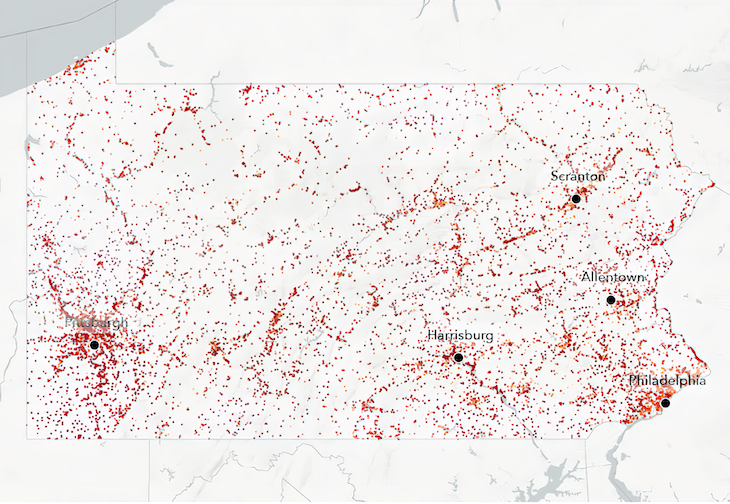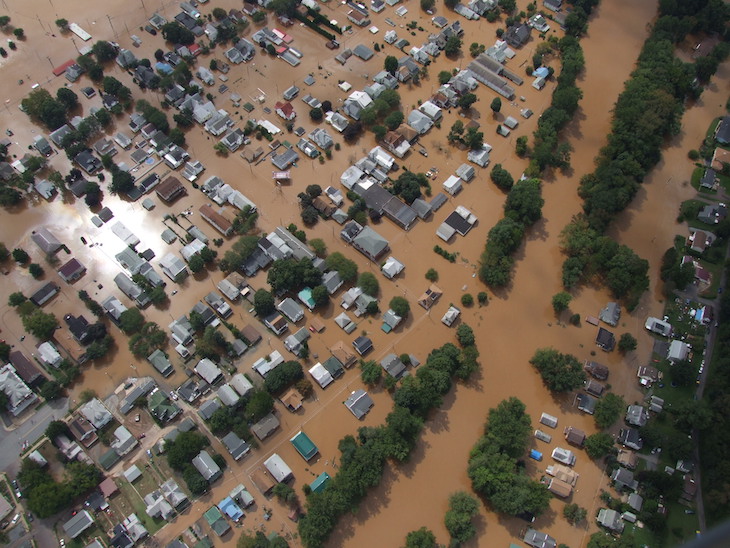Pennsylvania could be the second-most flooded state in 2022 behind Florida, new study shows

A study from First Street Foundation found that Pennsylvania is at high risk for structural damage from flooding, both from natural and manmade disasters. Commonwealth Media Services
From Johnstown to the remnants of Hurricane Ida, almost every town in the commonwealth has a flood story.
In 1972, the remnants of Hurricane Agnes battered the Harrisburg area, causing more than $13 billion in damage in 2022 dollars and forcing Gov. Milton Shapp to evacuate the governor’s mansion. Just a few years later, Johnstown experienced the third most devastating flood in its history, resulting in 84 deaths and damages totaling $2 billion in 2022 dollars. Then, in 2004, the remnants of Hurricane Ivan swept through central Pennsylvania causing more than $300 million in damages.
While officials at all levels of government have worked to improve flood prevention, mitigation and recovery efforts in the decades since these disasters, a troubling new report indicates that they may still not be ready for what’s to come.
RELATED ARTICLES
A study conducted by the nonprofit research and technology group First Street Foundation analyzing the potential impact of increased flooding has found that the commonwealth trails only Florida for potential structural damage, and that three Pennsylvania cities are at serious risk of office, retail, and residential damage.
The foundation’s 4th National Risk Assessment on Climbing Commercial Closures takes into account the potential structural damage, lost days of operation and downstream economic impacts based on current and future estimates of flood hazards. The analysis, which measured the flood risks and impacts in metropolitan areas, found that Pittsburgh, Philadelphia and Harrisburg will face significant damage-related losses, and that Pennsylvania as a whole will see the second-highest aggregate total structural damage costs of $1.22 billion among all states this year.
“As flooding severity and frequency changes along with a changing climate, increasing commercial flood risk understanding is especially important,” according to the study. “Understanding the flood risk to commercial markets is crucial to providing communities and policymakers the information needed to guide investment, mitigation, and adaptation.”

In the Pittsburgh region, about 36% of all office, retail and multi-unit residential properties are at risk of flooding this year. The region’s total estimated damages amount to nearly $450 million – the third-highest in the nation. Philadelphia, with an estimated $208 million in damages, and Harrisburg, with an estimated $148 million in damages, rank 11th and 15th in the nation, respectively.
Richard Vilello, deputy secretary of community affairs and development at the Pennsylvania Department of Community and Economic Development, said flooding has become a growing issue across the commonwealth.
“This is getting more and more serious every year,” Vilello told City & State. “One of the things that we’ve seen is the trend to more isolated flooding events, larger storms kind of parking over an area … neighborhoods that have never been flooded before getting flooded.”
Disaster relief funds and flood insurance are critical for businesses and property owners to facilitate the cleanup and recovery from flooding. Relief funds typically come from the federal government through the Federal Emergency Management Agency. Depending on the size and impact of a storm or flood, emergency declarations can come from local officials, the governor or the federal government. Counties must meet individual thresholds based on population and the state must reach $19.6 million in damages to be eligible for federal disaster assistance.

Following the devastation from the remnants of Hurricane Ida last summer, particularly in the southeast, Gov. Tom Wolf called on FEMA to lower the threshold for federal aid.
“While my administration is working diligently to support recovery efforts, substantial gaps remain when these localized events do not meet federal damage assessment thresholds. As a result, victims are left to pick up the pieces with little to no financial support,” Wolf said in a statement at the time. “I’m requesting that FEMA adjust the thresholds to better reflect current weather trends that, as a result of climate change, are causing these intense rainstorms and impacting communities, including those that typically do not experience flooding.”
When asked what kind of response Wolf received, his office responded with the following: “We have not yet received a formal response from FEMA. However, Gov. Wolf continues to believe this is a necessary action to be considered as the frequency of these intense weather events increases as a result of climate change. We must be able to support Pennsylvanians impacted by this global crisis, which is why Gov. Wolf proposed a $10 million State Disaster Assistance Fund in his 2022-23 budget proposal.”
Ida is just the most recent example of Pennsylvanians dealing with major flooding and water damage. What began as a Category 4 hurricane in Louisiana became Tropical Storm Ida by the time it made its way north and ultimately causing the Schuylkill River to crest just below its 17-foot record set in 1869, wreaking more than $100 million in public infrastructure damage.

Philadelphia-area businesses are getting more acclimated to dealing with flooding from natural and manmade disasters. A water main break in Center City Philadelphia in 2018 caused substantial damage to roads and businesses. It created about six inches of flooding and led to almost a year’s worth of repair work before several blocks of Sansom Street could be reopened. While the break stood out for its scope, such failures have become increasingly common: The city’s water department repaired 677 water main breaks in 2020 alone.
Jason Evenchik, owner of several Philadelphia restaurants, including Time and BAR on the 1300 block of Sansom Street that suffered the most damage from the break, said Time experienced about $275,000 worth of water damage. He said that although it took a month or two to reopen, the lack of foot traffic resulted in revenue being cut in half for about six months before returning to pre-flood numbers – just before the pandemic hit.
“I don’t know why [the city] is spending money on river projects when there are infrastructure issues to deal with,” Evenchik told City & State. “These projects are going forward, yet there’s major infrastructure that needs to be taken care of … that’s being ignored.”
The issues related to water damage boil down to prevention, mitigation and recovery. The City of Philadelphia assists business owners in connecting with disaster relief funds, and, in the case of Ida, coordinated with FEMA on cleanup and property damage assessments, Karen Guss, a spokesperson for the city’s Department of Licenses and Inspections, said in an email.

The federal infrastructure bill passed last year is expected to bring billions of dollars to the state to help address issues related to its crumbling infrastructure, storm and wastewater management systems and more.
With instances of flooding and severe storms expected to increase, government agencies must consider holistic approaches to not just react to floods, but be proactive in lessening the damage caused by them, Vilello said. Having also served four terms as the mayor of Lock Haven, Vilello said that the study and response efforts fall short of identifying the impacts in smaller communities around the state.
“There are 2,500 other municipalities where this is an issue. It’s a growing issue,” Vilello said. “We really need to look long-term on resiliency, mitigation and prevention.”
The three Pennsylvania metropolitan areas examined in the National Risk Assessment have flood implications that go beyond the city limits. According to the study, areas near Philadelphia, like Levittown and Chester, are expected to experience the most significant increases in structural damage and lost operational days due to flooding. In central Pennsylvania, Enola, Hershey and Shippensburg are expected to experience similar upticks, and near Pittsburgh, Tarentum and West View are among the areas most at risk.

One of the groups tasked with combating this growing problem is the State Planning Board, which is comprised of local and business officials, legislators and agency leaders. It works with the governor’s office and DCED to prepare a land use and growth management report every five years. Vilello said now the board is finalizing development and zoning recommendations to best handle flooding issues.
“There are places in the world that have done a better job. I mean, there are places in Europe that have flooded for years and have had levee systems and have dealt with it,” Vilello said. “We’re going to have to deal with it with the Delaware River, the Ohio River Basin in Pittsburgh, the Susquehanna River. All of that is going to be affected. We have to look generationally, not just for next year; we have to look, 30, 40 and 50 years down the road.”
The proactive measures are necessary because the reactive policies are very limited, Vilello said. In many cases, flood insurance may cover structural damage but not any damage done to equipment or inventory, meaning it would come out of the pockets of business owners. Business interruption insurance could offer more coverage beyond just the property damage, but that can also be pricey.
“They’re pretty expensive policies with a pretty high deductible,” Vilello said. “That’s why we really lean on preventative measures and mitigation measures. Because after the fact, there’s not a lot of good coverage, there’s not a lot of good programs, and it’s a challenge getting up and running again for both businesses and communities.”

Evenchik joked that the loss of business following water damage was the “gift that kept giving.” While there are options to offer more relief grants or low-interest loans to businesses affected by flooding, loans aren’t helping the business owners in the long run.
“Low-interest loans basically kick the ball down the road,” Evenchik said. “We’re still incurring debt.” He said officials should consider offering need-based grants to businesses that are struggling.
The study recommends government officials utilize the vulnerability data to adapt their strategies, particularly weighing the difference in impacts among urban and rural communities. It states the indicators are “useful for governments to understand the risk as it relates to their local tax base, and to plan accordingly. Large impacts for local economies may result in lower tax revenues, slower economic growth and generally unhappy citizens. Outside of these investment concerns, the results provided here can be used as inputs for areas which hope to develop more comprehensive risk models, especially as related to economic impacts.”
Vilello echoed the study’s conclusions regarding the need for a holistic approach now and in the future. “It all impacts the local community,” he emphasized, “which affects the local government, which affects the business climate.”
